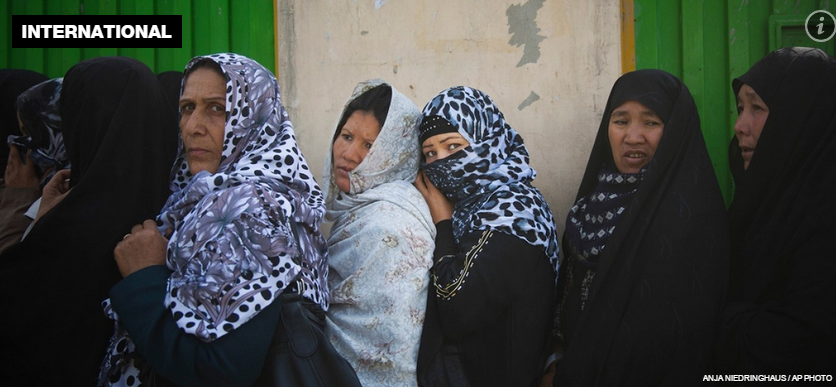Source: Aljazeera
Government watchdog: Millions of dollars spent on projects for Afghan women, with no verification of success
December 18, 2014 12:01AM ET
by Jamie Tarabay @jamietarabay
An audit of the hundreds of millions of dollars spent by the United States on programs designed to benefit Afghan women found the success of the efforts cannot be comprehensively assessed because the U.S. agencies involved could not track their spending and results, according to a report released on Thursday.
The report, released by the Office of Special Inspector General for Afghanistan Reconstruction (SIGAR), which oversees U.S. spending efforts on reconstruction, states that the Defense and State Departments and the U.S. Agency for International Development (USAID) were unable to identify the portions of programs that specifically related to Afghan women.
There is no way to tell if the substantial gains made by Afghan women since 2001 — more and better medical care and training, for example — were directly connected to U.S. efforts, SIGAR argues. And the inability to show where those gains occurred hampered future planning and funding decisions.
This will be exacerbated, SIGAR concludes, as the U.S. military and other personnel reduce their numbers on the ground in Afghanistan.
President Barack Obama last month approved an increase in the number of U.S. troops remaining in Afghanistan after the official withdrawal at year’s end to 10,800 from 9,800. They will be expected to focus on training Afghan forces and take part in counterterrorism operations against Al-Qaeda fighters. But the diminished footprint will shrink the U.S. military’s ability to check on the progress of projects it is funding. The State Department and USAID officials will also have travel restrictions in areas with security concerns, and will instead rely on local operators. The prospect of curbed outreach has been continually raised as a concern by SIGAR, because U.S. funding for Afghanistan’s reconstruction will continue — at least $5 billion a year for the next four years.
“Although agencies plan to continue or increase funding supporting Afghan women, none of them have a plan to track overall progress and assess the results and outcomes of their efforts beyond 2014,” SIGAR reported.
The investigation looked at spending between 2011 and 2013, since an earlier probe in 2010 found similar challenges. At the time, SIGAR issued recommendations for the government departments to consolidate their approaches.
Of the funding dedicated to projects to benefit women, some $64 million went to 652 programs.
SIGAR and USAID said these programs altogether had components that specifically supported women, but could not identify what those were. “We were unable to independently verify the information or compare it to data the agency had previously provided to us,” SIGAR wrote. “This exemplifies the inconsistencies in USAID’s tracking of programming and funding supporting Afghan women.”
USAID said it wasn’t possible to obtain an accurate breakdown by gender of the impact projects like roads or power plants would have on a region.
Additionally, USAID’s deputy comptroller said the agency couldn’t track funding by gender because it’s not a category in the financial management system the agency uses. But SIGAR pointed out that USAID “provided a summary of women’s programming to a congressional committee in 2013 that identified specific programs and funding amounts benefiting Afghan women and girls.”
The Defense Department said it tracks the money it spends on the Afghan National Security Forces (ANSF) through line items like infrastructure, equipment, transportation and training, and is not gender specific.
DOD said it “partially concurred” with SIGAR’s findings. “DOD will produce a series of quarterly reports detailing what portion of the funding made available in the National Defense Authorization Act for FY2014 is being applied toward women in the ANSF,” the Pentagon wrote, adding that the reports sent to Congress were “sufficient.”
USAID and the State Department disagreed with SIGAR’s recommendations and asked to have them dismissed, saying they could “demonstrate a strong link between U.S. investments and the dramatic gains of women and girls.”
USAID says it has helped train more than 74,000 teachers, of whom nearly 30 percent were women. Nearly 8,000 scholarships to disadvantaged women were distributed in 23 provinces, and more than 1,300 loans that went to Afghan women enterprises came out of USAID’s budget.
USAID said trying to make agency-wide assessments of each program would only add layers of bureaucracy and would be counter-productive.
While USAID was able to detail where a portion of the $64 million for projects dedicated to women went, SIGAR countered that USAID could not demonstrate that improvements in the numbers of women and girls now in school, for example, were the result of hundreds of millions of U.S. taxpayer dollars.
“For example, State and USAID commented that 3 million girls are now enrolled in primary and secondary school, but they did not identify what specific U.S. program made that possible, how much was spent on the endeavor, or what the eventual outcome of the enrollment was,” SIGAR wrote.


